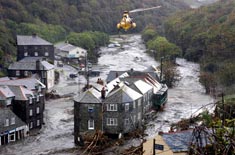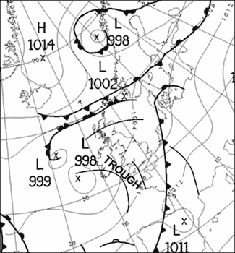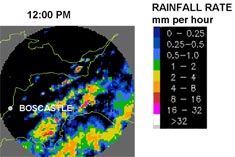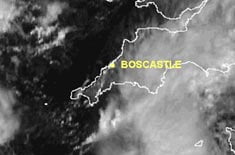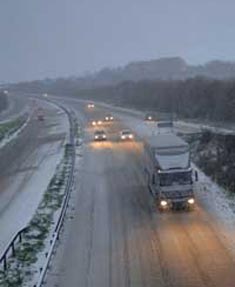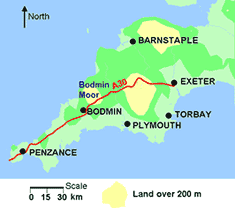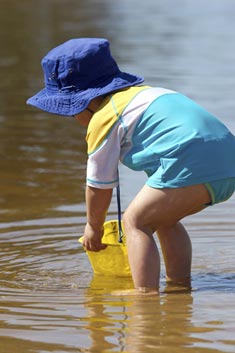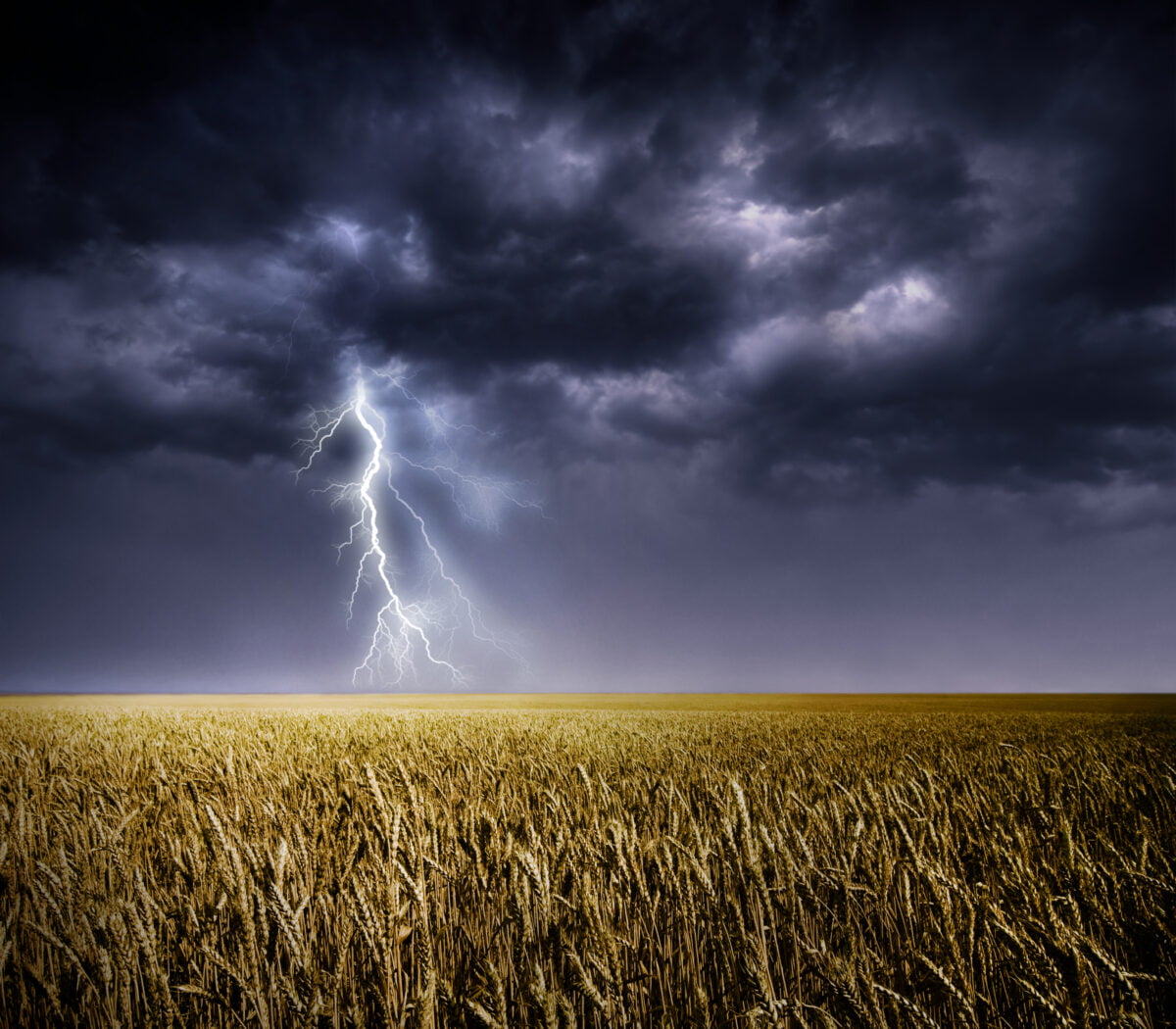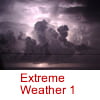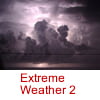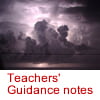The Great Storm of 1987
A powerful storm ravaged many parts of the UK in the middle of October 1987.
With winds gusting at up to 100mph, there was massive devastation across the country and 18 people were killed. About 15 million trees were blown down. Many fell on to roads and railways, causing major transport delays. Others took down electricity and telephone lines, leaving thousands of homes without power for more than 24 hours.
Buildings were damaged by winds or falling trees. Numerous small boats were wrecked or blown away, with one ship at Dover being blown over and a Channel ferry was blown ashore near Folkestone. While the storm took a human toll, claiming 18 lives in England, it is thought many more may have been hurt if the storm had hit during the day.
The storm gathers
Four or five days before the storm struck, forecasters predicted severe weather was on the way. As they got closer, however, weather prediction models started to give a less clear picture. Instead of stormy weather over a considerable part of the UK, the models suggested severe weather would pass to the south of England – only skimming the south coast.
During the afternoon of 15 October, winds were very light over most parts of the UK and there was little to suggest what was to come. However, over the Bay of Biscay, a depression was developing. The first gale warnings for sea areas in the English Channel were issued at 6.30 a.m. on 15 October and were followed, four hours later, by warnings of severe gales.
At 12 p.m. (midday) on 15 October, the depression that originated in the Bay of Biscay was centred near 46° N, 9° W and its depth was 970 mb. By 6 p.m., it had moved north-east to about 47° N, 6° W, and deepened to 964 mb.
At 10.35 p.m. winds of Force 10 were forecast. By midnight, the depression was over the western English Channel, and its central pressure was 953 mb. At 1.35 a.m. on 16 October, warnings of Force 11 were issued. The depression moved rapidly north-east, filling a little as it went, reaching the Humber estuary at about 5.30 am, by which time its central pressure was 959 mb. Dramatic increases in temperature were associated with the passage of the storm’s warm front.
Warning the public
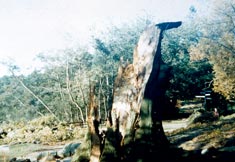 During the evening of 15 October, radio and TV forecasts mentioned strong winds but indicated heavy rain would be the main feature, rather than strong wind. By the time most people went to bed, exceptionally strong winds hadn’t been mentioned in national radio and TV weather broadcasts. Warnings of severe weather had been issued, however, to various agencies and emergency authorities, including the London Fire Brigade. Perhaps the most important warning was issued by the Met Office to the Ministry of Defence at 0135 UTC, 16 October. It warned that the anticipated consequences of the storm were such that civil authorities might need to call on assistance from the military.
During the evening of 15 October, radio and TV forecasts mentioned strong winds but indicated heavy rain would be the main feature, rather than strong wind. By the time most people went to bed, exceptionally strong winds hadn’t been mentioned in national radio and TV weather broadcasts. Warnings of severe weather had been issued, however, to various agencies and emergency authorities, including the London Fire Brigade. Perhaps the most important warning was issued by the Met Office to the Ministry of Defence at 0135 UTC, 16 October. It warned that the anticipated consequences of the storm were such that civil authorities might need to call on assistance from the military.
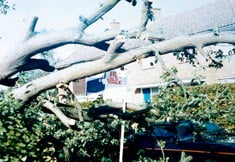 In south-east England, where the greatest damage occurred, gusts of 70 knots or more were recorded continually for three or four consecutive hours. During this time, the wind veered from southerly to south-westerly. To the north-west of this region, there were two maxima in gust speeds, separated by a period of lower wind speeds. During the first period, the wind direction was southerly. During the latter, it was south-westerly. Damage patterns in south-east England suggested that whirlwinds accompanied the storm. Local variations in the nature and extent of destruction were considerable.
In south-east England, where the greatest damage occurred, gusts of 70 knots or more were recorded continually for three or four consecutive hours. During this time, the wind veered from southerly to south-westerly. To the north-west of this region, there were two maxima in gust speeds, separated by a period of lower wind speeds. During the first period, the wind direction was southerly. During the latter, it was south-westerly. Damage patterns in south-east England suggested that whirlwinds accompanied the storm. Local variations in the nature and extent of destruction were considerable.
How the storm measured up
Fig. 1 shows maximum gusts (in knots) during the storm.
Comparisons of the October 1987 storm with previous severe storms were inevitable. Even the oldest residents of the worst affected areas couldn’t recall winds so strong, or destruction on so great a scale.
- The highest wind speed reported was an estimated 119 knots (61 m/s) in a gust soon after midnight at Quimper coastguard station on the coast of Brittany (48° 02′ N 4° 44′ W).
- The highest measured wind speed was a gust of 117 knots (60 m/s) at 12.30 am at Pointe du Roc (48° 51′ N, 1° 37′ W) near Granville, Normandy.
- The strongest gust over the UK was 100 knots at Shoreham on the Sussex coast at 3.10 am, and gusts of more than 90 knots were recorded at several other coastal locations.
- Even well inland, gusts exceeded 80 knots. The London Weather Centre recorded 82 knots at 2.50 am, and 86 knots was recorded at Gatwick Airport at 4.30 am (the authorities closed the airport).
A hurricane or not?
TV weather presenter Michael Fish will long be remembered for telling viewers there would be no hurricane on the evening before the storm struck. He was unlucky, however, as he was talking about a different storm system over the western part of the North Atlantic Ocean that day. This storm, he said, would not reach the British Isles — and it didn’t. It was the rapidly deepening depression from the Bay of Biscay which struck.
This storm wasn’t officially a hurricane as it did not originate in the tropics — but it was certainly exceptional. In the Beaufort scale of wind force, Hurricane Force (Force 12) is defined as a wind of 64 knots or more, sustained over a period of at least 10 minutes. Gusts, which are comparatively short-lived (but cause a lot of destruction) are not taken into account. By this definition, Hurricane Force winds occurred locally but were not widespread.
The highest hourly-mean speed recorded in the UK was 75 knots, at the Royal Sovereign Lighthouse. Winds reached Force 11 (56–63 knots) in many coastal regions of south-east England. Inland, however, their strength was considerably less. At the London Weather Centre, for example, the mean wind speed did not exceed 44 knots (Force 9). At Gatwick Airport, it never exceeded 34 knots (Force 8).
The powerful winds experienced in the south of England during this storm are deemed a once in 200 year event — meaning they were so unusually strong you could only expect this to happen every two centuries. This storm was compared with one in 1703, also known as a ‘great storm’, and this could be justified. The storm of 1987 was remarkable for its ferocity, and affected much the same area of the UK as its 1703 counterpart.
Northern Scotland is much closer to the main storm tracks of the Atlantic than south-east England. Storms as severe as October 1987 can be expected there far more frequently than once in 200 years. Over the Hebrides, Orkney and Shetland, winds as strong as those which blew across south-east England in October 1987 can be expected once every 30 to 40 years.
The 1987 storm was also remarkable for the temperature changes that accompanied it. In a five-hour period, increases of more than 6 °C per hour were recorded at many places south of a line from Dorset to Norfolk.
The aftermath
Media reports accused the Met Office of failing to forecast the storm correctly. Repeatedly, they returned to the statement by Michael Fish that there would be no hurricane — which there hadn’t been. It did not matter that the Met Office forecasters had, for several days before the storm, been warning of severe weather. The Met Office had performed no worse than any other European forecasters when faced with this exceptional weather event.
However, good was to come of this situation. Based on the findings of an internal Met Office enquiry, scrutinised by two independent assessors, various improvements were made. For example, observational coverage of the atmosphere over the ocean to the south and west of the UK was improved by increasing the quality and quantity of observations from ships, aircraft, buoys and satellites, while refinements were made to the computer models used in forecasting.
Strength of gusts

Web page reproduced with the kind permission of the Met Office
Other MetLink resources linked to the 1987 storm:
Weather articles:
Damage to trees and woodlands in the storm of 15-16 October 1987, Quine, 1988
The Storm of 15-16 October 1987: A personal experience, H.D.Lawes, 1988
The Great Storm of 1987, Burt & Mansfield, 1988
The storm, the Media and the Enquiry, J. Houghton, 1988



